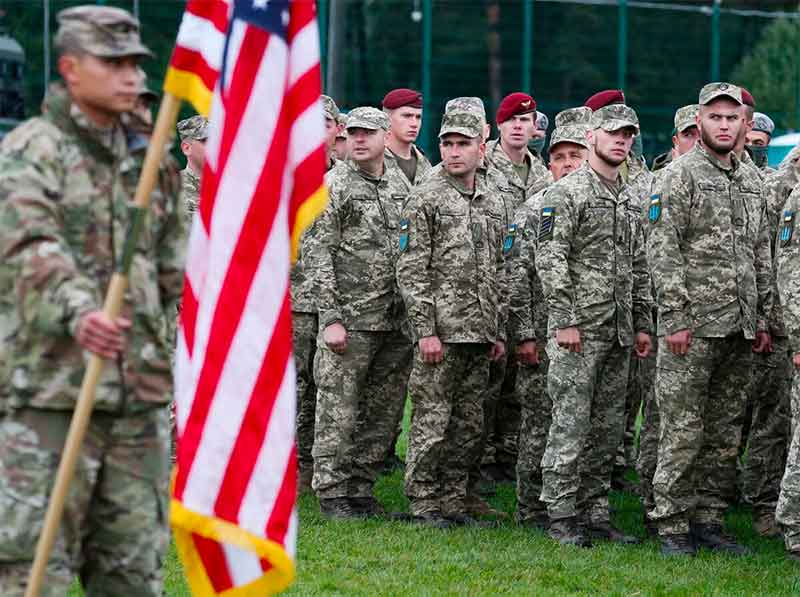
On Monday, US President Joe Biden arrived in Kiev, the capital of Ukraine, pledging the United States’ commitment to the war with Russia for “as long as it takes.” The visit by the “commander in chief” to the front solidifies the conflict not only as an American war but as the defining and preeminent focus of the Biden administration.
Coming a few days before the one-year anniversary of the war and on the eve of a major speech by Russian President Vladimir Putin, Biden’s visit is intended to convey the message: The United States is all in.
Biden’s visit to this active war zone was, in the words of White House Communications Director Kate Bedingfield, “risky” and “unprecedented,” but “this was a risk that Joe Biden wanted to take.”
While Biden’s visit may have been “risky,” it was not unprecedented. In July 1944, US President Franklin Roosevelt gathered all of his leading Pacific commanders at Pearl Harbor, Hawaii, to discuss the final conquest of Japan. Within 13 months, the United States would drop two atomic bombs on Hiroshima and Nagasaki, killing as many as a quarter million people.
At the end of 1966, President Lyndon B. Johnson visited South Vietnam, inaugurating a major escalation of US involvement in the Vietnam War. Throughout the next year, more than 11,000 US service members would lose their lives, up from 6,000 the year before.
In his visit to Kiev, Biden is attempting to make the US-NATO commitment to the escalation of war irreversible.
There is mounting opposition to war within the population, while Biden’s constant invocations of “unity” within NATO speak to deep concerns about how far the United States’ NATO allies are willing to go toward direct war with Russia.
In a comment published Monday, Financial Times columnist Gideon Rachman wrote, “There comes a point in many wars where the warring sides wonder what they have got themselves into.” Russia reached this stage in September, he stated, but is now going on the offensive. “With the first anniversary of Russia’s invasion falling this week, it is the western alliance backing Ukraine that is having difficult policy debates.”
Biden’s visit to Kiev comes amid major setbacks for America’s proxy forces in Ukraine which have been armed and equipped at the cost of over $100 billion. Rachman notes, “[T]he Ukrainian economy is in deep trouble and dependent on western aid. For this reason, influential western analysts argue that time is not on Ukraine’s side—and that if Kyiv is to win, it must do so quickly.”
Beneath the public declarations of optimism at this weekend’s Munich Security Conference, NATO officials quietly warned that the situation facing the Ukrainian Armed Forces is dire. “We are in urgent war mode,” said Josep Borrell, the European Union’s top diplomat. “This shortage of ammunition has to be solved quickly; it is a matter of weeks,” otherwise, Ukraine faces the prospect of military defeat.
These statements testify to a growing recognition that Ukraine’s army is suffering massive losses and faces the prospect of collapse without urgent reinforcement.
War has a logic of its own, which at a certain point becomes a major factor in the escalation itself. The US and NATO powers instigated the reactionary Russian invasion of Ukraine one year ago, which has been followed by the deployment of ever greater sums of money and military equipment to the field of battle.
Any retreat at this point would entail a devastating defeat for NATO and a collapse of US influence in Europe. The entire credibility of NATO and, in particular, of American imperialism is at stake. This makes war until complete victory an existential issue for US imperialism.
Biden’s visit to Kiev also explodes any remaining pretense that the US and NATO are not direct parties in the conflict with Russia. But if this is a NATO war, it will require NATO troops.
Biden’s visit has been preceded by a coordinated shift by US government officials, Ukrainian officials and the US media to publicly expand the scope of US involvement and introduce the concept of “boots on the ground.”
On Friday, US Under Secretary of State for Political Affairs Victoria Nuland openly endorsed, for the first time, Ukrainian strikes inside Crimea. “Those are legitimate targets,” Nuland said. “Ukraine is hitting them. We are supporting that.”
Over the weekend, former National Security Council official Alexander Vindman declared in an interview with the Associated Press that all restraints are being lifted on US intervention in Ukraine. “I feel increasingly confident that [the White House will] provide everything and anything that the Ukrainians need,” he said. “It’s just going to be a matter of time.”
Over the weekend, the US media began to moot the prospect of deploying ground troops to Ukraine. On Saturday, the Washington Post called for NATO to deploy “a convincing array of military muscle on the ground.” Chuck Todd, the host of “Meet the Press,” the leading US political talk show, asked, “Will the US and its allies be able to defeat Putin without putting any NATO or US boots on the ground?”
Ukrainian officials, meanwhile, are becoming even more explicit in articulating the goals of their paymasters in Washington. On Sunday, Oleksiy Danilov, the head of Ukraine’s Security Council, told the Sun: “Our tanks will be on Red Square [in the Russian capital of Moscow] and that will be justice.”
On Monday, the day that Biden arrived in Kiev, the New York Times published an op-ed advocating the destruction of Russia as a nation-state, declaring, “Russia will not be a democracy until it falls apart.”
The expansion of the US war aims confronts the reality, however, that the official stated policy of Russia is to use nuclear weapons to defend its territory, including Crimea.
In response to this reality, US officials are making clear that they fully accept the prospect of nuclear war. As Eliot Cohen of the Center for Strategic and International Studies stated in a recent interview, for US officials to accept that they will be limited by the threat of Russian nuclear retaliation would mean that “we’ve been deterring ourselves.”
The US needs a “a real defense industrial mobilization,” Cohen said. This must be accompanied by “a concerted effort to explain to the American people why this war is really central to our interests.”
How, precisely, will the ruling class “explain” to the American people that it is in “our interests” to risk nuclear war over Ukraine? It is worth bearing in mind the statements of Zbigniew Brzezinski, who in the years prior to the September 11 terrorist attacks wrote that “the pursuit of power [i.e., US global hegemony] is not a goal that commands popular passion, except in conditions of a sudden threat or challenge to the public’s sense of domestic well-being.”
The public has not been told a fraction of what Biden, after traveling for 20 hours by train, discussed while he was in Kiev, both with Washington’s proxy forces and with those CIA and US military personnel, who are already on the ground in Ukraine.
Biden’s visit makes clear that the United States is committed to a massive escalation of the war, with incalculable consequences for the population of Ukraine, Russia and the entire world.
Originally published in WSWS.org















































